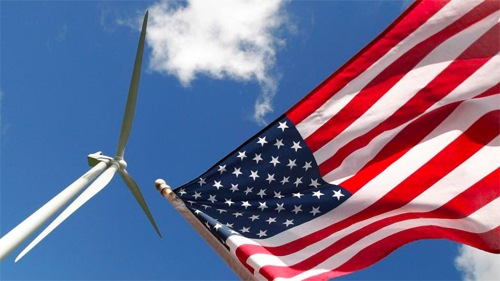In a meeting on Friday, February 21, South Dakota Governor Dennis Daugaard, Washington Governor Jay Inslee, and Oregon Governor John Kitzhaber — the chairman, vice chairman and past chairman of the Governors’ Wind Energy Coalition — and Federal Energy Regulatory Commissioners, discussed a wide range of topics, including transmission development, grid modernization, regional cooperation, coordinated regional operations, and ways in which the Commissioners and the governors can work together to promote the more rapid deployment of wind energy in the United States.
“The value of wind energy resources to our states’ economies cannot be unlocked unless they have access to a market,” said South Dakota Governor Dennis Daugaard, chairman of the Coalition. “Long-distance transmission is the critical link between these resources and the customers who want clean and less expensive energy.”
“The Commissioners and we come from different backgrounds, but we all agree the revitalization of the nation’s electrical transmission system must be a national priority and accomplished on a regional and cooperative multi-state basis,” said Washington Governor Jay Inslee and vice chairman of the Coalition. “The electrical transmission system is as important today to our states’ economic development as the nation’s interstate highway system was 50 years ago.”
“Expanding and modernizing the nation’s domestic electrical transmission system, both on shore and off shore, is an essential component in revitalizing the nation’s economy and creating jobs,” said Oregon Governor John Kitzhaber, former chairman of the Coalition. “The nation’s high voltage networks are aging. Most were planned and built for yesterday’s electricity markets and uses and were intended for power systems based on large power plants common in the mid 20th century. The transmission system is inadequate for the electrical demands of the states’ modern information-based economies. Robust transmission infrastructure increases connectivity and provides a foundation for competitive business frameworks that states can offer to retain existing businesses as well as those in the future.”
“Transmission can strengthen reliability, reduce congestion costs, and connect new generation resources to the grid,” Acting FERC Chairman Cheryl LaFleur said. “We welcome the support of the governors in helping to advance the development of our nation’s electric transmission system.”
The Governors identified multiple activities they would pursue over the next year including:
- Inform the nation’s governors on the positive state economic impact of improving our transmission infrastructure.
- Support state and regional cooperation on transmission development through collaboration among state policy makers, state utility commissions and system operators. The Upper Midwest Transmission Development Initiative is an excellent example of governors working collaboratively to advance transmission development in one area of the nation. MISO’s MVP planning process and the Southwest Power Pool’s regional plans are successful interstate initiatives that moved forward with FERC’s support to get new power to markets.
- Remove state legislative barriers to transmission siting, such as those that don’t allow state utility commissions to consider economic, reliability, environmental, and functional benefits beyond state boundaries in considering transmission siting.
- Establish one-stop shops for transmission siting in states. About half of the states use this approach, which better enables transmission development. One stop shopping can streamline the state process, identify unnecessary bottlenecks more evident, and signal to developers that states would welcome responsible, necessary modernization.
- Support coordinated regional operations as a way to meet wind integration needs that is built on a foundation of reliability, capacity, adequacy and economic efficiency.
- Examine how the U.S. EPA’s anticipated existing power plant greenhouse gas standard could benefit wind development.
- Support state and regional demand response and smart grid policies that improve overall system efficiency, reliability, and resilience, and aid in the integration of increasing amounts of distributed energy resources such as wind energy.
“The nation’s governors, FERC Commissioners, and state utility commissions all play an important role in transmission development,” Governor Daugaard said. “We strongly agree that the development of the high voltage transmission system must be a national and state policy and regulatory priority. We look forward to working together to advance the nation’s transmission development,”
The Governors’ Wind Energy Coalition is a bipartisan group of the nation’s governors who are dedicated to the development of the nation’s wind energy resources to meet America’s domestic energy demands in an environmentally responsible manner — while reducing the nation’s dependence on imported energy sources and stimulating state and national economic development.
Through its multi-state coordinated efforts, the Coalition is engaged in several national initiatives: encouraging sound national policy and legislation for the development and distribution of wind-generated energy; communicating, and demonstrating the value and benefits of wind energy to consumers, energy companies and policy makers; sharing state best practices in wind and renewable energy policy development; creating an environment of support for those who wish to develop responsible wind energy resources; and supporting development of infrastructure for the expansion of wind energy across the United States.
For more information, visit www.GovernorsWindEnergyCoalition.org


